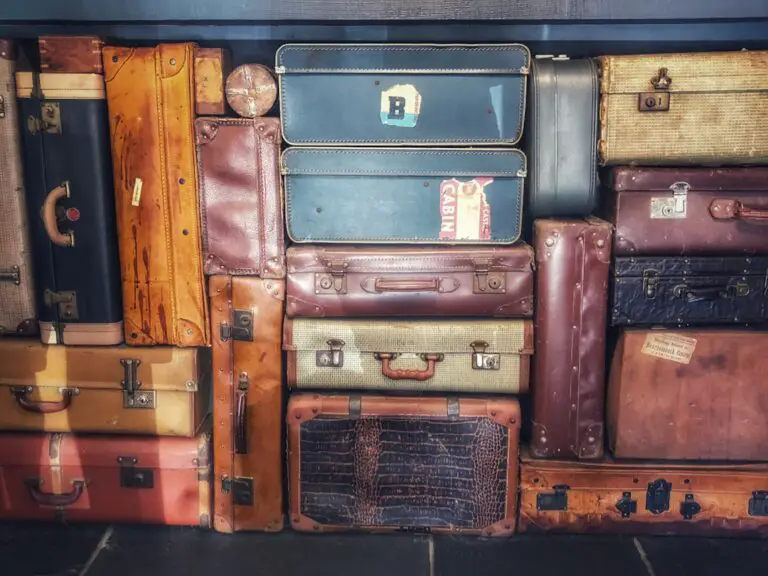Support our educational content for free when you purchase through links on our site. Learn more
What 7 Essential Documents to Pack for a 5-Day Trip ✈️ (2025)
Packing for a quick 5-day getaway might seem straightforward—just toss your clothes in a bag and you’re good to go, right? But when it comes to travel documents like your passport and ID, the stakes are much higher. Imagine arriving at the airport only to realize you forgot a crucial document. Nightmare! Did you know that over 20% of travelers face delays or denied boarding due to missing or invalid documents? 😱
In this guide, we’ll walk you through the 7 essential documents you absolutely must pack for any 5-day trip—whether it’s a domestic flight, an international adventure, or even a cruise. Plus, we’ll reveal insider tips on digital backups, special cases like traveling with kids or pets, and why a birth certificate might not cut it for your next Galveston cruise. Ready to travel smarter and stress-free? Let’s dive in!
Key Takeaways
- Passport and government-issued ID are your travel MVPs—never leave home without them, especially for international trips.
- Boarding passes, itinerary, and payment cards complete your core document set for smooth check-ins and purchases.
- Special documents like visas, vaccination records, and parental consent letters can be deal-breakers depending on your destination and travel companions.
- A hybrid approach with physical originals and secure digital backups is the safest way to protect your documents.
- Invest in RFID-blocking travel wallets and organizers to keep your documents safe and accessible on the go.
👉 Shop Travel Document Organizers & RFID Wallets:
- Bellroy Travel Folio on Amazon | Bellroy Official Website
- Pacsafe RFIDsafe Organizer on Amazon | Pacsafe Official Website
- Zoppen RFID-Blocking Travel Wallet on Amazon | Walmart
Table of Contents
- ⚡️ Quick Tips and Facts
- Passport & ID Essentials: A Brief History of Travel Documentation
- The Core Four: Your Must-Have Travel Documents for Any Trip
- Domestic vs. International: What’s the Difference for Your 5-Day Getaway?
- Beyond the Basics: Niche Documents You Might Need for Your Trip
- Health & Wellness: Vaccinations, Prescriptions, and Medical Records
- Travel Insurance: Your Safety Net on the Road
- Visa Requirements: Navigating International Entry
- Proof of Onward Travel & Accommodation: Showing Your Intentions
- Student IDs & Senior Discounts: Unlocking Savings
- Work & Business Travel Permits: When Leisure Meets Livelihood
- Digital Documents vs. Physical Copies: The Great Debate for Travelers
- Safeguarding Your Sensitive Information: Tips for Secure Travel
- Special Considerations: Who Needs What for Their Trip?
- Packing Your Document Pouch: Our Top Gear Picks for Organization
- The “Oops!” Moment: What Happens If You Forget Something Crucial?
- Conclusion
- Recommended Links
- FAQ
- Reference Links
Here is the main body of the article, from the “Quick Tips and Facts” section to the section before “Conclusion”.
⚡️ Quick Tips and Facts
Welcome, savvy travelers! Before we dive deep into the nitty-gritty of travel documentation, let’s get you started with some rapid-fire wisdom. Think of this as your travel document appetizer. And while you’re thinking about what documents to pack, don’t forget to check out our ultimate guide on What should I pack for 5 days away? for everything else you’ll need.
- The Golden Rule: For any international travel, even a short 5-day trip, your passport is non-negotiable. Don’t leave home without it!
- The Six-Month Secret: Many countries require your passport to be valid for at least six months beyond your planned departure date. Check your expiration date now. Seriously, go look. We’ll wait.
- Domestic Bliss: For travel within your own country (like the U.S.), a REAL ID-compliant driver’s license or state ID is usually all you need for flights. ✅
- Cruise Control: That 5-day Galveston cruise might be a “closed-loop” sailing, which has more lenient document rules (like a birth certificate and ID). But what if you have an emergency in a foreign port? We’ll unpack this later, but spoiler alert: we always recommend a passport.
- Digital vs. Physical: Never trust technology 100%. Keep digital copies of your documents in a secure cloud service like Dropbox or Google Drive, but always carry the physical originals.
- Kiddos on Board: Traveling with children under 18? You’ll likely need their birth certificates and, if traveling without the other parent, a signed consent letter. This is a must for our Family Vacation Checklists.
- Money Talks: Don’t forget your financial “documents”—credit cards and debit cards. Pro Tip: Always inform your bank of your travel dates to avoid a sudden, embarrassing card freeze.
Passport & ID Essentials: A Brief History of Travel Documentation
Ever wonder why we even have these little booklets and plastic cards? It wasn’t always this complicated! In the past, travel was often a freer affair. But as nations became more defined, so did the need to identify who belonged where. The modern passport system really took off after World War I, as countries sought to enhance security and control their borders. Think of your passport not as a bureaucratic burden, but as your personal storybook, a globally recognized “hall pass” that says, “Yep, I’m with them!” It’s your golden ticket to the world’s wonders, from the beaches of Bali to the mountains of Peru.
The Core Four: Your Must-Have Travel Documents for Any Trip
Alright, let’s get down to business. No matter where you’re going for your 5-day jaunt, these four categories of documents are the absolute bedrock of your travel kit.
1. 🛂 Passport Power: Your Global Golden Ticket
For any trip that crosses an international border, your passport is the undisputed king. It’s the one document that universally proves your identity and citizenship.
- When You Need It: All international air travel. Period. It’s also the best and most reliable document for sea and land crossings.
- Validity is Key: As we mentioned, the six-month validity rule is a trip-killer for the unprepared. Countries want to ensure you can legally stay and also leave without your passport expiring mid-trip.
- Passport Cards vs. Books: The U.S. Passport Card is a handy, wallet-sized ID, but it’s only valid for land and sea travel to Canada, Mexico, Bermuda, and the Caribbean. It is NOT valid for international air travel. For a 5-day fly-away, you need the full passport book.
2. 🆔 Government-Issued ID: Beyond the Basics
When you’re staying within your country’s borders, a government-issued photo ID is your best friend.
- Domestic Flights: In the United States, the Transportation Security Administration (TSA) requires a REAL ID-compliant driver’s license or other acceptable form of ID to fly.
- Beyond the Airport: You’ll need it for hotel check-ins, car rentals, and sometimes even for entry to specific venues or locations. As the travel guide for West Point points out, certain gates are “ONLY for DoD ID card holders,” showing that even domestic sites can have strict ID checks.
- REAL ID Check: Not sure if your license is compliant? Look for a star marking. If you don’t have one, check with your state’s DMV to see what other documents you might need.
3. ✈️ Boarding Passes & Itinerary: Your Trip’s Blueprint
“Winging it” is a fun travel philosophy, but it shouldn’t apply to your core logistics. Having your travel plan organized is crucial.
- Boarding Passes: While mobile boarding passes on apps like the Delta or American Airlines app are super convenient, batteries die. We are huge fans of having a printed copy tucked away as a backup. You never know when you’ll face a dead phone or a glitchy app.
- Full Itinerary: This includes flight confirmations, hotel booking details (with addresses!), car rental reservations, and any tour or event tickets. A simple printout or a well-organized digital folder can save you a world of frantic searching for a confirmation number.
4. 💳 Credit/Debit Cards & Cash: Financial Freedom on the Go
Your money is your lifeline on the road. Don’t get caught short!
- Credit Cards: Ideal for major purchases (hotels, flights) and offer better fraud protection. Cards like the Chase Sapphire Preferred or American Express Gold are popular among travelers for their rewards and benefits.
- Debit Cards: Best for withdrawing local currency from ATMs. Be aware of foreign transaction fees!
- Cash is King (Sometimes): Always carry some local currency for small purchases, tips, or in case you land in a “cash-only” situation. You don’t want to be unable to pay for a taxi from the airport!
Domestic vs. International: What’s the Difference for Your 5-Day Getaway?
So, you’ve got your 5-day trip booked. Hooray! But do you need a passport to go from Chicago to Miami? (Spoiler: no). What about from Miami to the Bahamas? (Spoiler: yes!). The line between domestic and international travel dictates your entire document strategy.
| Travel Type | Primary ID Needed | Passport Required? | Key Considerations |
|---|---|---|---|
| Domestic (within your country) | REAL ID-Compliant Driver’s License/State ID | ❌ No | Simple and straightforward. Just your ID and itinerary will do. |
| International (crossing a border) | Passport Book | ✅ Yes! | Check visa rules, passport validity, and any required health documents. This is where our International Travel Checklists become essential. |
Cruising Concerns: Do I Need a Passport for a Closed-Loop Cruise?
This is one of the most hotly debated topics in travel forums. A “closed-loop” cruise is one that starts and ends in the same U.S. port (like a 5-day trip from Galveston to Mexico and back). Technically, U.S. citizens can often board these cruises with just their original birth certificate and a government-issued photo ID.
But should you? Our expert advice at Travel Checklist™ is a resounding NO.
Imagine this: you’re enjoying a beautiful day in Cozumel, but you have a medical emergency or miss the ship’s departure. Without a valid passport book, flying back to the U.S. becomes a massive, stressful, and expensive bureaucratic nightmare. A passport is your “get out of jail free” card in these situations. Don’t risk it.
Road Tripping Across Borders: Car Documents & Insurance
Planning to drive into Canada or Mexico? Fantastic! But your car needs a “passport” too.
- Vehicle Registration & Driver’s License: These are a given.
- Car Insurance: Your U.S. auto insurance is often accepted in Canada, but you should always get a “Canada Inter-province Insurance Card” from your provider as proof. For Mexico, you must purchase separate Mexican auto liability insurance. Your U.S. policy is not valid there. Companies like Baja Bound or Allstate offer policies specifically for travel to Mexico.
Beyond the Basics: Niche Documents You Might Need for Your Trip
The Core Four will get you through most doors, but some trips require a little extra paperwork. Think of these as the specialist tools in your travel kit.
Health & Wellness: Vaccinations, Prescriptions, and Medical Records
- Proof of Vaccination: Some countries require proof of vaccination for diseases like Yellow Fever (the “Yellow Card”) for entry, especially if you’re arriving from a region where it’s prevalent. Check the CDC’s travel website for your destination’s requirements.
- Prescription Medications: Keep meds in their original labeled bottles. It’s also wise to carry a copy of the prescription or a doctor’s note, especially for controlled substances.
Travel Insurance: Your Safety Net on the Road
We never travel without it. If you get sick, miss a flight, or lose your bags, travel insurance can be a financial lifesaver. Keep a digital and physical copy of your policy information, including the 24/7 emergency assistance phone number. Popular providers include World Nomads and SafetyWing.
Visa Requirements: Navigating International Entry
A visa is official permission from a foreign country to enter. It’s not the same as a passport! For a short 5-day trip, many countries offer visa-free travel to U.S. citizens, but many others do not. Always check the U.S. Department of State’s website for your destination’s entry requirements months in advance.
Proof of Onward Travel & Accommodation: Showing Your Intentions
Some immigration officials want to see proof that you don’t plan on overstaying your welcome. This means having a printed confirmation of your flight home and your first night’s accommodation can smooth your entry process.
Student IDs & Senior Discounts: Unlocking Savings
If you’re a student or a senior, that ID card is pure gold! It can unlock discounts on everything from museum entries to train tickets. Don’t be shy about asking!
Work & Business Travel Permits: When Leisure Meets Livelihood
Are you a digital nomad or traveling for work? Be careful. Working, even on a laptop in a café, can violate the terms of a tourist visa in some countries. Ensure you have the correct work permit if necessary. It’s a key part of our Digital Nomad Checklists.
Digital Documents vs. Physical Copies: The Great Debate for Travelers
In our hyper-connected world, it’s tempting to go completely paperless. But when it comes to crucial travel documents, is that a wise move? Let’s break it down.
✅ The Case for Digital: Convenience at Your Fingertips
Having copies of your passport, ID, and itineraries stored securely in the cloud (think Google Drive, Dropbox, or a password manager like 1Password) is brilliant. If your bag gets stolen, you can access them from any internet-connected device. It’s a fantastic backup system.
❌ The Case for Physical: When Tech Fails You
What happens when your phone battery dies right as you get to the security line? Or when the border agent in a remote location doesn’t accept a picture of a passport? Or when there’s no Wi-Fi? Physical documents are tangible, universally accepted, and require no power source. They are the ultimate fail-safe.
Our Expert Recommendation: A Hybrid Approach to Document Management
Don’t choose. Use both. This is the only truly safe strategy.
- Carry the originals of your passport, ID, and any required physical documents.
- Keep digital backups of everything stored in a secure, offline-accessible cloud folder.
- Have physical photocopies of your passport and visas stored in a separate bag from the originals. This can expedite the replacement process if the originals are lost or stolen.
Safeguarding Your Sensitive Information: Tips for Secure Travel
Your documents are valuable. Protecting them is just as important as remembering to pack them.
Pre-Trip Prep: Photocopies, Digital Backups, and Emergency Contacts
Before you even leave, make those physical and digital copies we just talked about. Also, email a copy to a trusted friend or family member back home. Leave a copy of your full itinerary with them as well.
On the Go: Secure Storage Solutions (Think RFID-Blocking!)
Don’t just toss your passport in your back pocket. Invest in a good travel document organizer. Many modern passports contain RFID chips with your personal data. An RFID-blocking wallet or passport holder can help prevent thieves from skimming this information.
- Travel Neck Wallet: Worn under your shirt, it keeps everything hidden and secure.
- Travel Money Belt: A classic for a reason. Slim, discreet, and effective.
- Secure Daypack: Brands like Pacsafe and Travelon make anti-theft bags with features like slash-proof fabric and locking zippers.
👉 Shop Secure Travel Organizers on:
- Pacsafe: Amazon | Pacsafe Official Website
- Travelon: Amazon | Travelon Official Website
- Bellroy: Amazon | Bellroy Official Website
What If Disaster Strikes? Reporting Lost or Stolen Documents
It’s the traveler’s worst nightmare, but it happens. If your passport is lost or stolen abroad:
- File a police report immediately in the local jurisdiction.
- Contact the nearest embassy or consulate for your home country. They are your lifeline and can help you get emergency travel documents to get home. This is why knowing where your embassy is located is a key pre-trip planning step.
Special Considerations: Who Needs What for Their Trip?
Not all travelers are created equal. Your personal circumstances can add a few extra items to your document checklist.
Families Traveling with Minors: Birth Certificates & Consent Letters
Traveling with kids is an adventure! But it requires extra paperwork to prove you have the right to take them across borders.
- Birth Certificates: Always bring the original or a certified copy of your child’s birth certificate to prove your relationship.
- Parental Consent Letter: If a child is traveling with only one parent or with another adult (like grandparents), you must have a signed and preferably notarized consent letter from the non-traveling parent(s). This helps prevent international parental child abduction.
Solo Travelers: Extra Vigilance, Extra Preparedness
When you’re on your own, your document safety net is all on you. Double down on the hybrid digital/physical backup strategy. Ensure your emergency contact information is written down in multiple places. This is a core principle for any Adventure Travel Checklists.
Travelers with Special Needs: Medical Letters & Accessibility Info
If you have a medical condition, carry a letter from your doctor detailing your condition, medications, and any necessary medical equipment. If you use a service animal, ensure you have all their required documentation and certifications.
Pet Parents: Fido’s Passport to Adventure
Taking your furry friend along? They need documents too! This can include a pet passport, up-to-date vaccination records, a health certificate from a vet issued shortly before travel, and microchip information. Requirements vary wildly by country, so research is critical.
Packing Your Document Pouch: Our Top Gear Picks for Organization
A jumble of loose papers is a recipe for panic. A good travel document organizer is a small investment that pays huge dividends in peace of mind. We love organizers that have dedicated slots for a passport, credit cards, boarding passes, and a pen.
Speaking of smart packing, the first YouTube video embedded above, “How to Pack a Carry-On Bag for a 5-Day Trip”, is a fantastic resource. While it focuses on clothes, the principle of smart, organized packing is exactly what you need for your documents too!
Our Favorite Document Organizers:
- Bellroy Travel Folio: Sleek, stylish leather with room for two passports, cards, and cash.
- Pacsafe RFIDsafe V150 Compact Organizer: A great non-leather option with top-tier RFID protection and organization.
- Zoppen Multi-Purpose RFID-Blocking Travel Wallet: A budget-friendly and highly-rated option with tons of color choices and space for the whole family’s documents.
👉 Shop Document Organizers on:
- Zoppen: Amazon | Walmart
- Bellroy: Amazon | Bellroy Official Website
- Pacsafe: Amazon | Pacsafe Official Website
The “Oops!” Moment: What Happens If You Forget Something Crucial?
Take a deep breath. It’s not necessarily the end of the world.
- Forgot Your ID for a Domestic Flight? You might still be able to fly. The TSA has alternative identity verification processes, but be prepared for extra screening and delays. Don’t count on it, but it’s a possibility.
- Forgot a Hotel Confirmation? You can almost always pull it up online or have the hotel find it with your name and credit card.
- Forgot Your Passport for an International Flight? This one… this one is tough. Unfortunately, you are almost certainly not getting on that plane. This is the one document where there is virtually no wiggle room. It’s the ultimate argument for creating a physical checklist and checking it twice before you walk out the door.
Conclusion
Phew! That was quite the journey through the world of travel documents, wasn’t it? Whether you’re jetting off internationally or hopping on a domestic flight for your 5-day adventure, packing the right documents is your first step to smooth travels. From the irreplaceable passport to the trusty government-issued ID, from your boarding passes to your emergency backups — each piece plays a vital role in your travel puzzle.
Remember our little cliffhanger about the closed-loop cruise? While a birth certificate and ID might technically get you onboard, Travel Checklist™ strongly recommends carrying a valid passport. It’s your safety net if plans go sideways — and trust us, they sometimes do.
Digital copies are fabulous for convenience, but never ditch your physical originals. A hybrid approach is the smartest way to keep your documents safe and accessible.
And don’t forget the extras — visas, vaccination cards, consent letters for minors, and pet passports if you’re bringing your furry friends along. These niche documents can save you from last-minute headaches.
Finally, invest in a good travel document organizer like the Bellroy Travel Folio or Pacsafe RFIDsafe to keep everything neat, secure, and ready for inspection.
Traveling smart with your documents means less stress, more fun, and the freedom to enjoy your trip without bureaucratic hiccups. So pack wisely, double-check, and get ready to explore the world with confidence!
Recommended Links
Ready to gear up for your next trip? Here are some top picks to keep your travel documents safe and organized:
-
Bellroy Travel Folio:
Amazon | Bellroy Official Website -
Pacsafe RFIDsafe V150 Compact Organizer:
Amazon | Pacsafe Official Website -
Zoppen Multi-Purpose RFID-Blocking Travel Wallet:
Amazon | Walmart -
Travel Insurance Providers:
World Nomads | SafetyWing -
Books to Help You Travel Smarter:
“The Travel Book: A Journey Through Every Country in the World” by Lonely Planet — Amazon
“How to Travel the World on $50 a Day” by Matt Kepnes — Amazon
FAQ
What are the essential travel documents required for international flights?
For international flights, the passport book is the absolute must-have. It proves your identity and citizenship. Many countries require your passport to be valid for at least six months beyond your travel dates. Additionally, you may need a visa depending on your destination, proof of onward travel, and sometimes vaccination certificates. Always check the official government or embassy websites for your destination’s specific requirements well before your trip.
How do I ensure my passport is valid for travel to my destination country?
Check your passport’s expiration date and compare it to your planned travel dates. Most countries require a minimum of six months validity beyond your return date. You can verify this via the U.S. Department of State’s travel site or your country’s equivalent. If your passport is expiring soon, renew it well in advance — expedited services are available but can be costly and stressful if left to the last minute.
Can I use a digital copy of my ID and travel documents, or are physical copies required?
While digital copies stored securely in the cloud or on your phone are excellent backups, physical originals are almost always required for official checkpoints like airport security and border control. Some airlines and countries may accept digital boarding passes, but passports and government-issued IDs must be presented in physical form. A hybrid approach—carrying originals plus digital backups—is the safest bet.
What other important papers should I pack besides my passport, ID, and travel itinerary?
Depending on your trip, consider packing:
- Visa documents if required
- Vaccination certificates (e.g., Yellow Fever, COVID-19)
- Travel insurance policy details
- Prescription medication documentation
- Parental consent letters and birth certificates if traveling with minors
- Work permits or business travel authorizations if applicable
- Pet health certificates and vaccination records if traveling with animals
Always tailor your document checklist to your destination and personal circumstances.
How do I replace a lost or stolen passport while traveling?
If your passport is lost or stolen abroad, immediately file a police report with local authorities. Then contact your country’s nearest embassy or consulate. They can issue an emergency travel document to get you home. This process can take several days, so having digital copies and photocopies of your passport can speed up verification. Always keep emergency contact numbers handy.
Are birth certificates and IDs sufficient for cruises like a 5-day Galveston trip?
For closed-loop cruises (starting and ending at the same U.S. port), U.S. citizens can often board with just a birth certificate and government-issued photo ID. However, Travel Checklist™ strongly recommends carrying a valid passport book. If you miss the ship or have an emergency in a foreign port, a passport is essential for re-entry to the U.S. Always check the cruise line’s official documentation requirements before you sail.
Reference Links
-
U.S. Department of State – Passport Requirements:
https://travel.state.gov/content/travel/en/passports.html -
Transportation Security Administration (TSA) – Identification Requirements:
https://www.tsa.gov/travel/security-screening/identification -
Centers for Disease Control and Prevention (CDC) – Travel Vaccinations:
https://wwwnc.cdc.gov/travel -
REAL ID Information – Department of Homeland Security:
https://www.dhs.gov/real-id -
U.S. Customs and Border Protection – Travel Tips:
https://www.cbp.gov/travel/us-citizens -
World Nomads Travel Insurance:
https://www.worldnomads.com/ -
SafetyWing Travel Insurance:
https://safetywing.com/ -
Pacsafe Official Website:
https://pacsafe.com/ -
Bellroy Official Website:
https://bellroy.com/ -
Zoppen Travel Wallets on Amazon:
https://www.amazon.com/s?k=Zoppen+Travel+Wallet -
Carnival Cruise Lines Facebook Group Post on Galveston Cruise Documents:
https://www.facebook.com/groups/CarnivalCruiseLines/posts/9589210667782681/
Safe travels and happy packing! 🌍✈️🛂




